As I awoke this morning I looked out my bedroom window and saw what Holly Reay and I have officially termed "fogus arcticus". There are so many names for different types of white stuff that fall from the sky along with different types of frost and fog. After spending the majority of my life in the Southwestern Desert, it takes some effort to recall all these new terms. So in our sleepy stupor and in the spirit of Roadrunner and Coyote cartoons we named it "fogus arcticus" for lack of a better name and effort to determine the correct term.
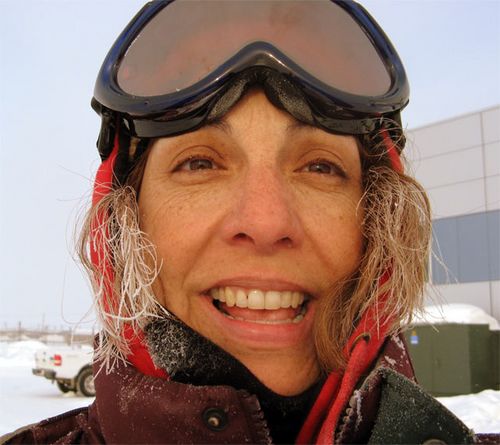 New gray hairs on Betsy Wilkening. The Arctic way of providing highlights.
New gray hairs on Betsy Wilkening. The Arctic way of providing highlights.
As the days of the OASIS project dwindle, I am finding that the scientists that are still working in Barrow linger a little longer in the cafeteria after meals. The conversation drifts off in many directions with talk of home and reflections of experiences here in Barrow. Ralf Staebler shared that in all of his time out on the sea ice that the native guides spoke to each other in their native Inupiaq language when it came to discussing the conditions outside. The Inupiaq language is much more efficient when discussing environmental conditions. In the book The Whale and the Supercomputer, Charles Wohlforth writes, "The very structure of Inupiaq helps deal with situations in a unique environment. Speakers can convey information quickly in a moving landscape without landmarks or any visible distinction between ocean and shore."
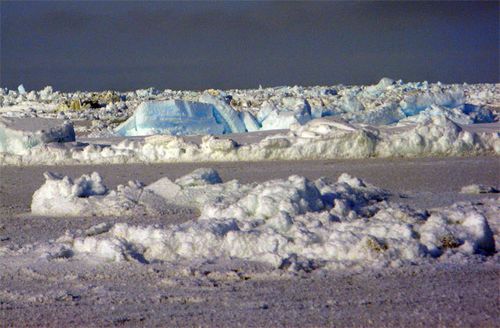 More blue ice on the frozen sea.
More blue ice on the frozen sea.
On evening at dinner, we discussed the next International Polar Year. If it continues with the 50-year cycle, it will be in 2059. Some of the younger scientists said that they would be around, although they would be well into their 70's. Since I will most likely not be around, I am hoping some of the students who are reading this will be involved.
On April 1st, Holly and I discovered a rare occurrence during our stay here. On our way to work it was snowing. The snow that was falling was very tiny flakes, not like the giant ones I experienced on my last night in Fairbanks. We took advantage of the fresh layer and made snow angels; something that Holly has never done in England. Our roommate Jin Liao took a picture of us.
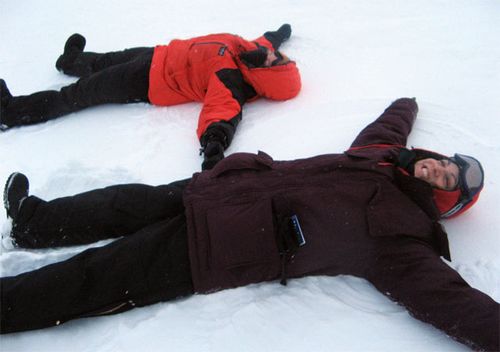 Holly Reay (top) and Betsy Wilkening (bottom) making snow angels in fresh snow outside of hut on way to work.
Holly Reay (top) and Betsy Wilkening (bottom) making snow angels in fresh snow outside of hut on way to work.
My last day went much more smoothly for me than it did for Harry Beine. It was decided that the snow group would start a 36-hour experiment on Friday 4/3. This will involve taking snow samples every 2 hours during the experiment and have each scientist involved look at different properties and chemicals present in the snow. While I helped Harry clean glassware to prepare for the upcoming experiment, his equipment decided to act up. He spent most of the day taking it apart and putting it back together. It worked for a little bit and then went haywire again. He was planning on contacting the manufacturer on Friday.
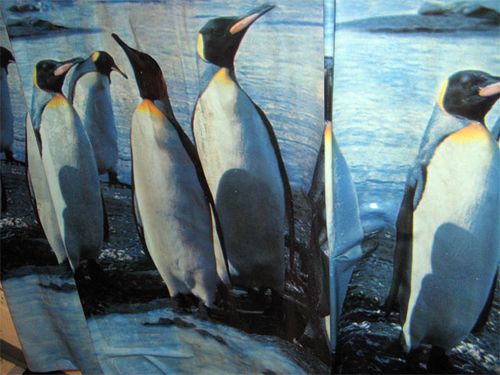 The only penguins I found in the Arctic were on a shower curtain in a hut at BASC.
The only penguins I found in the Arctic were on a shower curtain in a hut at BASC.
We finished up the day with a birthday celebration for one of the scientists and a farewell party for me and a few others.
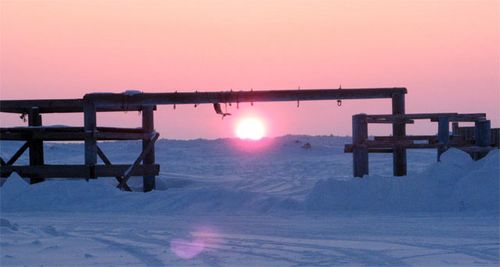 The sun setting over the frozen ocean at about 9:30 PM.
The sun setting over the frozen ocean at about 9:30 PM.
